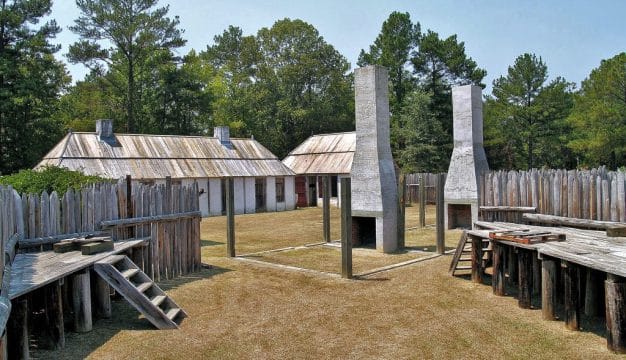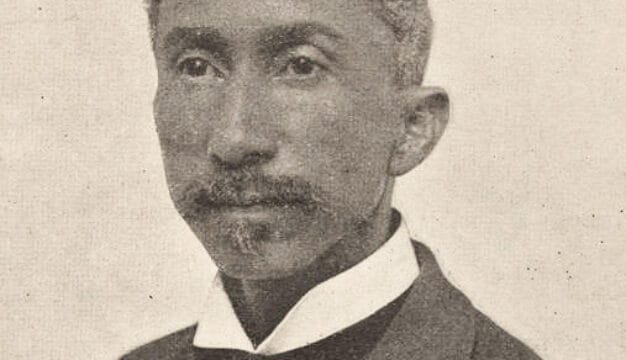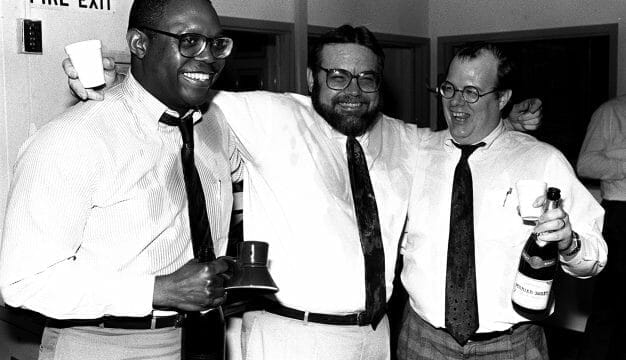Ku Klux Klan in Alabama during the Reconstruction Era
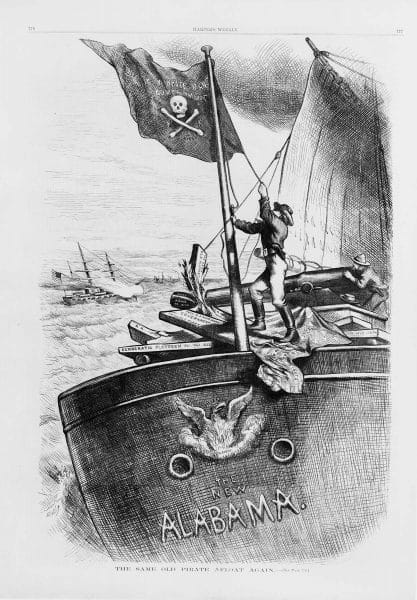 Anti-Confederate Cartoon, 1874
The Ku Klux Klan was a secretive and violent organized group that first appeared in Alabama during Reconstruction and operated from 1867 until 1871. By today’s standards and definitions, the early Klan would be considered a terrorist group, and its reign of terror helped define the history and memory of Reconstruction in Alabama. The Klan’s name derived from the Greek word kuklos, which meant “band” or “circle.” Thousands of Klansmen statewide used acts of intimidation and violence to oppose the expansion of civil liberties among freedpeople that took place during Reconstruction, to assert authority over black laborers, to defend white supremacy, and to eliminate the Republican Party. Many Klan members were also motivated by the mistaken idea that violence would restore the South to its plantation-era society, an ideology known as the Lost Cause.
Anti-Confederate Cartoon, 1874
The Ku Klux Klan was a secretive and violent organized group that first appeared in Alabama during Reconstruction and operated from 1867 until 1871. By today’s standards and definitions, the early Klan would be considered a terrorist group, and its reign of terror helped define the history and memory of Reconstruction in Alabama. The Klan’s name derived from the Greek word kuklos, which meant “band” or “circle.” Thousands of Klansmen statewide used acts of intimidation and violence to oppose the expansion of civil liberties among freedpeople that took place during Reconstruction, to assert authority over black laborers, to defend white supremacy, and to eliminate the Republican Party. Many Klan members were also motivated by the mistaken idea that violence would restore the South to its plantation-era society, an ideology known as the Lost Cause.
Six Confederate veterans in Pulaski, Tennessee, organized the Ku Klux Klan in May or early June of 1866. According to legend, the men created the Klan because they were bored and reportedly entertained themselves by donning costumes and playing pranks on freedpeople. In 1867, the Klan evolved into a counterrevolutionary organization responding to the widespread social change begun by Congressional Reconstruction. The Klan selected former Confederate general Nathan Bedford Forrest to serve as its Grand Wizard, as the supreme leader was known. The organization spread quickly under Forrest’s leadership; however, the Klan lacked a regional hierarchical chain of command. Although Klansmen bestowed titles of authority, such as Grand Dragon (state leader), Grand Cyclops (president), Grand Magi (vice-president), and Grand Turk (marshal), upon its leaders, local members were disconnected from state or regional leaders.
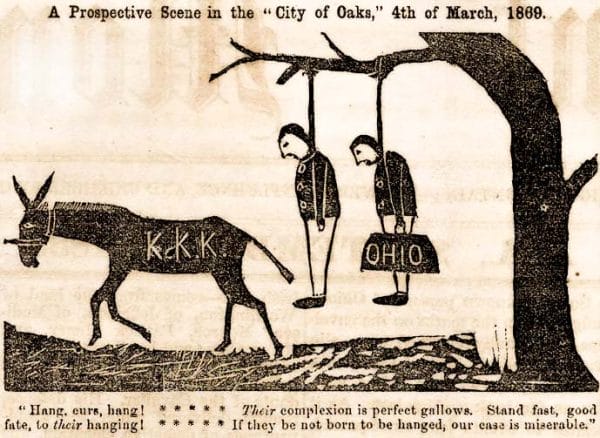 Klan Cartoon, 1868
The Klan established a loosely affiliated network of local “dens” in northern Alabama within months after the order’s creation. Historians are unsure about the precise number of Klansmen in Alabama. The group left no formal records and lack any known membership rolls; however, most historians estimate that in Alabama, at its peak, the organization had over 1,000 members and almost unanimous support among Democrats. The Alabama Klan existed in large numbers in counties located in the Tennessee River Valley, Piedmont, and Black Belt regions. Meanwhile, few Klan chapters existed in the Wiregrass, where the number of white Republican voters was larger and freedpeople represented a small percentage of the total population. The group’s membership included white men of varying social classes as well as many Confederate veterans. For example, James H. Clanton, a lawyer and former Confederate general who lived in Montgomery, was Alabama’s first Grand Dragon. Following Clanton’s murder in 1871, John Tyler Morgan, an ex-Confederate general and a future six-term U.S. senator from Alabama, held the position of Grand Dragon for several years. General Edmund Pettus of Dallas County was the last person to hold that title during Reconstruction. Other prominent Klan leaders in Alabama included Ryland Randolph, editor of the Tuscaloosa newspaper Independent Monitor, public Klan figure, and Confederate veteran, and Episcopal Bishop of Alabama Hooker Wilmer, who served as the state Klan chaplain. Several other white supremacist groups also formed in Alabama that imitated but possessed no true relation to the Ku Klux Klan.
Klan Cartoon, 1868
The Klan established a loosely affiliated network of local “dens” in northern Alabama within months after the order’s creation. Historians are unsure about the precise number of Klansmen in Alabama. The group left no formal records and lack any known membership rolls; however, most historians estimate that in Alabama, at its peak, the organization had over 1,000 members and almost unanimous support among Democrats. The Alabama Klan existed in large numbers in counties located in the Tennessee River Valley, Piedmont, and Black Belt regions. Meanwhile, few Klan chapters existed in the Wiregrass, where the number of white Republican voters was larger and freedpeople represented a small percentage of the total population. The group’s membership included white men of varying social classes as well as many Confederate veterans. For example, James H. Clanton, a lawyer and former Confederate general who lived in Montgomery, was Alabama’s first Grand Dragon. Following Clanton’s murder in 1871, John Tyler Morgan, an ex-Confederate general and a future six-term U.S. senator from Alabama, held the position of Grand Dragon for several years. General Edmund Pettus of Dallas County was the last person to hold that title during Reconstruction. Other prominent Klan leaders in Alabama included Ryland Randolph, editor of the Tuscaloosa newspaper Independent Monitor, public Klan figure, and Confederate veteran, and Episcopal Bishop of Alabama Hooker Wilmer, who served as the state Klan chaplain. Several other white supremacist groups also formed in Alabama that imitated but possessed no true relation to the Ku Klux Klan.
The Klan targeted freedpeople, white Republicans, northern missionaries, and teachers working in black schools. Groups rarely committed their terroristic acts during the day, preferring to operate in isolated, rural areas and generally at night, thus earning them the alternate name “nightriders.” Klansmen would target a house and arrive under the cover of darkness and surround the building, knock down any locked doors, and drag their victims out into the yard. Klansmen would then commit various acts of physical and psychological torture that included whippings of men, women, and children and dragging their victims around after the beatings. Disguised attackers routinely intimidated their victims by aiming loaded pistols at them. Very often, women in the household were subject to rape and other forms of violent and humiliating sexual abuse.
The Klan operated as the military wing of the Democratic Party in Alabama. Although few Democrats praised the Klan’s tactics publicly, many of the party’s leaders were Klansmen, and the party never repudiated the organization’s brutality. The group’s central objective was to halt the development of the Republican Party, and Klansmen accomplished this goal by physically assaulting and intimidating white and black party supporters. In Alabama, the rise of the Klan in 1868 led to an immediate and substantial decline in Republican voters. During the 1870 gubernatorial election, the Klan unleashed a wave of terror in such Republican-heavy counties as Greene and Sumter and kept thousands of potential voters away from the polls. With the Klan’s support, Democratic Party candidate Robert B. Lindsay achieved a narrow victory (1,409 votes statewide) over his Republican opponent William H. Smith. That same year, the Klan also restored the Democratic Party to power in the state legislature and in turn sent Democrat George T. Goldthwaite to the U.S. Senate.
The Klan also opposed many of the social changes in Alabama that had resulted from emancipation, including the development of independent black schools and churches. Klansmen routinely forced out white northern schoolteachers sent to the state by organizations such as the American Missionary Association. They also burned numerous black schools and churches—both types of places where freedpeople held political meetings—in an effort to thwart the development of black educational, religious, and political aspirations.
Between 1868 and 1871, according to testimony gathered by a special investigation conducted by members of the U.S. Congress, Klansmen in Alabama committed more than 100 murders and thousands of acts of violence and intimidation. In July 1870, for example, Klansmen killed six people, including a schoolteacher, at Cross Plains, Calhoun County. Local freedpeople identified the murderers by name during a grand jury hearing, but the all-white jury refused to indict the killers, and in fact, few Klansmen were ever brought to justice. Klansmen and most Democrats referred to members of the Republican Party as “Black Republicans”—regardless of whether the person they were referring to was white or black. The Klan and other white southerners believed that the Republican Party was acting to serve the interests of freedpeople and northern radicals whose support for the expansion of civil liberties among freedpeople designed to humiliate and reduce the South to a permanent subordinate status within the nation.
By the end of 1871, the number of reported Klan sightings in Alabama declined sharply as a result of the actions of Pres. Ulysses S. Grant, who launched an aggressive campaign to eradicate the clandestine order. That campaign followed a series of violent incidents across the South that convinced Republican leaders that the Klan’s actions had significantly impaired any progress toward peacefully restoring the Union. The diminishing presence of the Klan statewide, however, failed to end the bloodshed. A stock market crash in September 1873 initiated a national economic recession that inspired a new wave of white-on-black violence in Alabama. The recession, coupled with several scandals, weakened the Grant administration’s ability to adequately support Reconstruction financially. By 1874, many former Klansmen had joined a new terrorist organization, the White League. Ultimately, the Klan’s brief yet violent existence failed to end Congressional Reconstruction. Support for the Republican Party in Alabama eroded as the result of the economic recession and a declining commitment among northern voters to continue funding Reconstruction. The election of conservative Democrat George S. Houston in 1874 ended Reconstruction in Alabama. Despite the fact that the Klan had ceased to exist during Reconstruction, during the late nineteenth and early twentieth centuries numerous witnesses and victims of white-on-black violence claimed that these acts had been carried out by masked Klansmen. During this period, most white Alabamians remembered the Klan fondly and credited the group with helping to overthrow Radical Republican rule and with defending the supremacy of the state’s white inhabitants. These favorable, yet inaccurate, interpretations kept the memory of the Klan alive and contributed to the organization’s rebirth in 1915.
Additional Resources
Fitzgerald, Michael. Splendid Failure: Postwar Reconstruction in the American South. Lanham, Md.: Ivan R. Dee, 2007.
Rable, George. But There Was No Peace: The Role of Violence in the Politics of Reconstruction. 2nd ed. Athens: University of Georgia Press, 2007.
Trelease, Allen W. White Terror: The Ku Klux Klan Conspiracy and Southern Reconstruction. Baton Rouge: Louisiana State University Press, 1971.
Weiner, Jonathan M. Social Origins of the New South: Alabama, 1860-1885. Baton Rouge: Louisiana State University Press, 1978).
